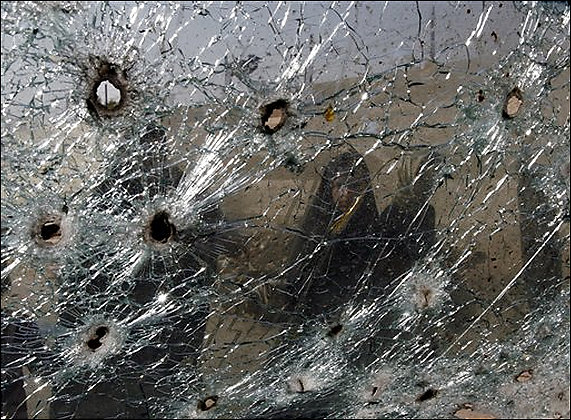The photograph has a haunting quality about it. At first glance it is hard to know what one is looking at. Attention is probably drawn initially to the three holes in the right side of the upper left quadrant that create something of a triangle and the menacing specter of a predatory face – a wolf perhaps – staring back at the viewer. Eventually, one’s eyes drift to the midpoint and notice the dark shadow which upon scrutiny turns out to be the image of a human face, possibly a woman though it is hard to tell; her expression, fractured and obscured by what we finally recognize as bullet-riddled glass, appears simultaneously cautious and curious. The question is, what does she see?
The caption provides the facts: “Iraqi women [yes, two women, at closer examination you can see the second shadow on the left side of the image] look through a bullet-riddled windshield after an overnight raid by U.S. troops in the Shiite enclave of Sadr City in Baghdad, Iraq, Aug. 12, 2007. Police and residents said U.S. and Iraqi troops backed by helicopters raided the east Baghdad neighborhood on early Sunday killing two people and wounding four others. The U.S. military said it was looking into the report.” The story to which the photograph is attached, as if an illustration, is a report that four U.S. soldiers were killed when a sniper shot one and then lured the others into a house rigged with a bomb.
The facts, it turns out, tell us very little. Even after careful study they prove to be no more than tidbits of data that confirm the obvious – women looking at a bullet-riddled window – and leave all else open to conjecture? But what do these women see? A world torn apart no doubt. But by whom? And why? Liberators protecting their world from an indigenous repressive regime? Or an occupying force guided by its own imperial designs? The picture doesn’t say, and the story only confuses the matter, but as the caption notes, the U.S. military is “looking” into it. Of course, what these women actually see or don’t see is only half of the problem – and perhaps the least of it.
The other half of the problem is that we don’t quite know what we see either. The photograph positions the viewer inside the vehicle looking out through the windshield. Windshields are contrivances of the modern world. One does not typically find them in the coaches, buggys, and surreys of an earlier century. They are transparent walls that segregate and insulate those on the inside from the outside world. Indeed, they are, in their fashion, modern veils produced by an advanced technological society, shielding those on the inside from the gaze of outside “others” (as external backlighting often obscures and distorts the vision of those who would peer in), even as they enable a certain scopic sovereignty to those on the inside to see the world around them. In this picture the windshield seems to separate the modern world from a foreign and archaic other. But here, of course, the protective layer afforded by technological superiority has been breached, the scopic regime fractured and distorted by another modern technology. No longer insulated from the elements and protected from the outside world, we see as “through a glass darkly,” a mirror that reflects back at us a vision of our own rapacious impulses.
But not to worry, for the military is looking into it.
Photo Credit: Karim Kadim/AP Photo

I’ve noticed these style photos in a few places over the last few weeks – pictures through glass with bullet holes in particular, but also a few viewing Iraqi citizens reflected in pools of blood. I seems like a sustained effort on the part of at least one photographer to make these images somewhat common place. I think these pictures function like the ones in your post at the BAGnewsNotes blog titled The Image at the End of the Tunnel- they elucidate a way of seeing through visual metaphor. Ignatieff, and other heads of state, are looking out through the windows of the tank-of-state. Regular viewers in the west see Iraq through the broken windsheilds and windows of news media, which emphasize violence. The typical way people in Iraq become visible is through some act of violence, and this photo plays up that fact with visual metaphor.